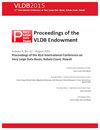Machine Learning for Subgraph Extraction: Methods, Applications and Challenges
IF 3.3
3区 计算机科学
Q2 COMPUTER SCIENCE, INFORMATION SYSTEMS
引用次数: 0
Abstract
Subgraphs are obtained by extracting a subset of vertices and a subset of edges from the associated original graphs, and many graph properties are known to be inherited by subgraphs. Subgraphs can be applied in many areas such as social networks, recommender systems, biochemistry and fraud discovery. Researchers from various communities have paid a great deal of attention to investigate numerous subgraph problems, by proposing algorithms that mainly extract important structures of a given graph. There are however some limitations that should be addressed, with regard to the efficiency, effectiveness and scalability of these traditional algorithms. As a consequence, machine learning techniques---one of the most latest trends---have recently been employed in the database community to address various subgraph problems considering that they have been shown to be beneficial in dealing with graph-related problems. We discuss learning-based approaches for four well known subgraph problems in this tutorial, namely subgraph isomorphism, maximum common subgraph, community detection and community search problems. We give a general description of each proposed model, and analyse its design and performance. To allow further investigations on relevant subgraph problems, we suggest some potential future directions in this area. We believe that this work can be used as one of the primary resources, for researchers who intend to develop learning models in solving problems that are closely related to subgraphs.子图提取的机器学习:方法、应用和挑战
子图是通过从关联的原始图中提取一个顶点子集和一个边子集来获得的,并且已知许多图的属性是由子图继承的。子图可以应用于许多领域,如社交网络、推荐系统、生物化学和欺诈发现。不同领域的研究人员对子图问题进行了大量的研究,提出了主要从给定图中提取重要结构的算法。然而,在这些传统算法的效率、有效性和可扩展性方面,有一些限制需要解决。因此,机器学习技术——最新的趋势之一——最近被应用于数据库社区,以解决各种子图问题,因为它们已被证明在处理图相关问题方面是有益的。在本教程中,我们讨论了四个众所周知的子图问题的基于学习的方法,即子图同构、最大公共子图、社区检测和社区搜索问题。我们给出了每个模型的一般描述,并分析了其设计和性能。为了进一步研究相关的子图问题,我们提出了该领域的一些潜在的未来方向。我们相信,这项工作可以作为主要资源之一,为那些打算开发学习模型来解决与子图密切相关的问题的研究人员。
本文章由计算机程序翻译,如有差异,请以英文原文为准。
求助全文
约1分钟内获得全文
求助全文
来源期刊

Proceedings of the Vldb Endowment
Computer Science-General Computer Science
CiteScore
7.70
自引率
0.00%
发文量
95
期刊介绍:
The Proceedings of the VLDB (PVLDB) welcomes original research papers on a broad range of research topics related to all aspects of data management, where systems issues play a significant role, such as data management system technology and information management infrastructures, including their very large scale of experimentation, novel architectures, and demanding applications as well as their underpinning theory. The scope of a submission for PVLDB is also described by the subject areas given below. Moreover, the scope of PVLDB is restricted to scientific areas that are covered by the combined expertise on the submission’s topic of the journal’s editorial board. Finally, the submission’s contributions should build on work already published in data management outlets, e.g., PVLDB, VLDBJ, ACM SIGMOD, IEEE ICDE, EDBT, ACM TODS, IEEE TKDE, and go beyond a syntactic citation.
 求助内容:
求助内容: 应助结果提醒方式:
应助结果提醒方式:


